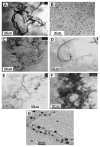Conjugation of quantum dots on carbon nanotubes for medical diagnosis and treatment
- PMID: 23487255
- PMCID: PMC3592558
- DOI: 10.2147/IJN.S36416
Conjugation of quantum dots on carbon nanotubes for medical diagnosis and treatment
Abstract
Cancer is one of the leading causes of death worldwide and early detection provides the best possible prognosis for cancer patients. Nanotechnology is the branch of engineering that deals with the manipulation of individual atoms and molecules. This area of science has the potential to help identify cancerous cells and to destroy them by various methods such as drug delivery or thermal treatment of cancer. Carbon nanotubes (CNT) and quantum dots (QDs) are the two nanoparticles, which have received considerable interest in view of their application for diagnosis and treatment of cancer. Fluorescent nanoparticles known as QDs are gaining momentum as imaging molecules with life science and clinical applications. Clinically they can be used for localization of cancer cells due to their nano size and ability to penetrate individual cancer cells and high-resolution imaging derived from their narrow emission bands compared with organic dyes. CNTs are of interest to the medical community due to their unique properties such as the ability to deliver drugs to a site of action or convert optical energy into thermal energy. By attaching antibodies that bind specifically to tumor cells, CNTs can navigate to malignant tumors. Once at the tumor site, the CNTs enter into the cancer cells by penetration or endocytosis, allowing drug release, and resulting in specific cancer cell death. Alternatively, CNTs can be exposed to near-infrared light in order to thermally destroy the cancer cells. The amphiphilic nature of CNTs allows them to penetrate the cell membrane and their large surface area (in the order of 2600 m(2)/g) allows drugs to be loaded into the tube and released once inside the cancer cell. Many research laboratories, including our own, are investigating the conjugation of QDs to CNTs to allow localization of the cancer cells in the patient, by imaging with QDs, and subsequent cell killing, via drug release or thermal treatment. This is an area of huge interest and future research and therapy will focus on the multimodality of nanoparticles. In this review, we seek to explore the biomedical applications of QDs conjugated to CNTs, with a particular emphasis on their use as therapeutic platforms in oncology.
Keywords: cancer; carbon nanotubes; cytotoxicity; drug delivery; near-infrared light; photothermal therapy; quantum dots.
Figures






References
-
- Chaudhary UB, Haldas JR. Long-term complications of chemotherapy for germ cell tumours. Drugs. 2003;63(15):1565–1577. - PubMed
-
- Moghimi SM, Hunter AC, Murray JC. Long-circulating and target-specific nanoparticles: theory to practice. Pharmacol Rev. 2001;53(2):283–318. - PubMed
-
- Lay CL, Liu HQ, Tan HR, Liu Y. Delivery of paclitaxel by physically loading onto poly(ethylene glycol) (PEG)-graft-carbon nanotubes for potent cancer therapeutics. Nanotechnology. 2010;21(6):065101. - PubMed
-
- Jamieson T, Bakhshi R, Petrova D, Pocock R, Imani M, Seifalian AM. Biological applications of quantum dots. Biomaterials. 2007;28(31):4717–4732. - PubMed
Publication types
MeSH terms
Substances
LinkOut - more resources
Full Text Sources
Other Literature Sources
Medical

